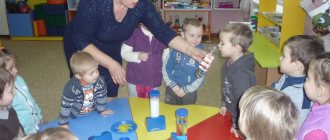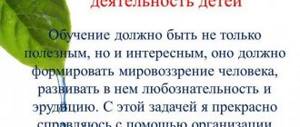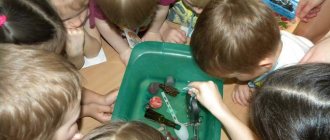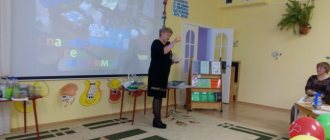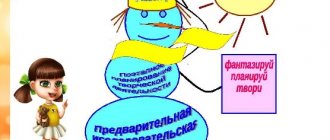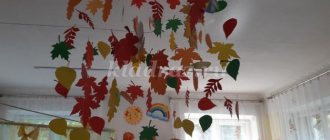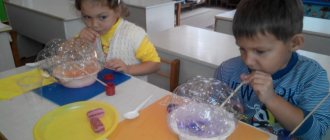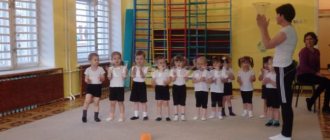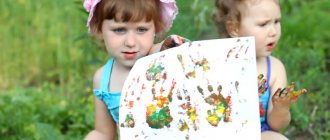Lesson on cognitive and research activities in the second junior group of kindergarten
Children 3–4 years old have an inquisitive mind; they can be interested in any subject in any situation, spontaneously. It is important for the teacher to notice such moments during the children’s independent activities in order to include them in joint research work. Elements of experimentation with younger preschoolers are used during classes on the surrounding world (“Orange, its features,” “What is snow”), during creative classes (“Mixing colors,” “Learning to sculpt from clay”), musical (“How do they sound?” metal, clay, porcelain bells"), etc. Observations on walks occupy a special place.
In the process of carrying out research activities, the teacher helps younger preschoolers at every stage of work. Speech accompaniment of all actions during experimentation is required (in the senior and preparatory groups, children will begin to pronounce their actions while the teacher does it for them). The teacher uses the direct demonstration method for the entire group and, if necessary, additionally for those children who have difficulties in performing the experiment.
During the experimentation process, the teacher talks through everything that is happening.
Children should not perceive research activities as specific work. The teacher does not prepare them for the profession of a scientist in the future, but teaches them exciting and effective ways to understand the world around them.
When constructing the practical part, the teacher takes into account the age characteristics of younger preschoolers. One research procedure can be divided into several separate stages. The learning process can be interrupted to prevent fatigue (playing and sports exercises, a musical break).
Table: forms of organizing research activities with children 3–4 years old
| Criteria for organizing research | Research forms |
| By the nature of the research objects |
|
| At the location of the experiment |
|
| Due to research |
|
| By the number of children participating in the experiment |
|
| By duration |
|
| By the nature of cognitive activity |
|
| By place in the cycle of educational activities |
|
| By the degree of inclusion in the educational process |
|
| By the nature of mental operations |
|
Card file of topics on research activities in the second junior group
| Research topic | Research objectives |
| "Sand and its properties" | Formation of ideas about sand, its properties in various states (dry and wet). |
| "What is the wind" | Learning the skills to study intangible objects using special instruments (to study the properties of wind you will need pinwheels, flags, nets, and a weather vane). |
| "Sun" | Expanding knowledge about the sun, the properties of its light and heat. |
| "Bubble" | Expanding knowledge about the properties of air. |
| "Stones" |
|
| "Fruits" | Learning to characterize the object of study in different aspects (lemon: by color - yellow, by smell - pleasant, aromatic, by taste - sour, by tactile sensation - smooth with small pimples, etc.). |
| "We are explorers" |
|
| "Snow and Ice" | Introducing children to the solid state of water, its characteristics, and the conditions for returning to the liquid state. |
| "Water and its properties" |
|
| "What smells?" | Developing children's sensory experience through smell. |
| "Roll, balls" |
|
| "Clay" |
|
| "Shadow" | Expanding knowledge about the ability of objects to cast shadows. |
| "The soil" | Formation of ideas about the soil (what it consists of) and its properties (it heats up, absorbs water, serves as a nutrient medium for plant growth). |
| "Paper boat" | Expanding knowledge about the properties of paper. |
| “Why do the buds bloom?” |
|
| "Chalk and Coal" | Formation of the ability to compare materials by properties and qualities. |
| "Drowning - not drowning" | Acquaintance with the ability of water to push objects made of rubber, plastic, wood, and foam. |
Motivating start to classes
Classes on cognitive activities with pupils of the younger group should be bright. A high level of curiosity and emotionality allows a preschooler to fill his long-term memory with images that impress him. How interested and involved the child is in the educational process at the beginning of the lesson depends on his activity during direct research activities, the result of solving the problem posed and the degree of motivation for experimentation in the future. The teacher needs to use a variety of forms for conducting the initial stage of the lesson, which will add variety to the usual activities of preschoolers.
Demonstration of the research object will help to arouse children’s interest at the beginning of the lesson.
Table: examples of a motivating start to a lesson
| Cognitive Research Topic | Option for a motivating start to the lesson |
| Forming children’s ideas about the properties of ice (lesson “Releasing beads from ice”) | Creating a surprise moment with a problematic situation. A Dymkovo toy comes to the group (in the role of a Dymkovo young lady - a pupil of the preparatory group, a senior teacher or another employee of the preschool educational institution by agreement), she is upset and complains to the children. The toy was invited to visit by a young lady she knew; she was in a hurry to have a friendly tea party and caught her beads on a branch in the winter forest. The thread broke and the beads scattered. The toy has collected them, but cannot string them on a thread because the beads are covered with ice (shows the children ice cubes with beads in the middle brought in a bowl). The guys will have to find a way to remove the beads so that the Dymkovo young lady can repair the jewelry and have time for a visit. |
| Introducing children to the properties of sand (lesson “Secrets of Sand”) | Game motivation. A fairy-tale guest is waiting in the group of children (it could be Aladdin, Dunno, etc.), he reports that he has arrived from the land of sands. The guest talks with the children (do they know what sand is, where they saw it, how they played with it), shows photographs of a wonderful country. He reports that he is ready to teach the children new games with sand, which the inhabitants of the land of sands love so much. |
| Formation in children of elementary ideas about how soap bubbles are made (lesson “How to make soap bubbles?”, preparation for the event “Bubble Festival”) |
|
| Cognitive development of children, working with flour and dough (integrated lesson “Wonderful Flour”) | Creating a game situation based on the previously studied fairy tale “Masha and the Bear”. At the beginning of the lesson, the teacher informs the children that near the garden she met a bear from a fairy tale: Everyone sit down in a row, Let's play nicely! Get your ears and eyes ready, let's begin our fairy tale. Today I came to the garden and found a roar bear. Mishka cried near the garden: “I want to go to kindergarten, to the kids!” Then the teacher asks what is the reason for the bear’s sadness (a plush toy can be used as a bear, or it is possible for a student in the senior group to play the role of a bear). Mishka says that Mashenka sent him to take the pies to his grandfather and grandmother, and he ate them on the way and is now sad that he violated the girl’s ban on not sitting on a tree stump and not eating the pie. The guys will help the bear by studying the characteristics of flour and methods of preparing and modeling dough (in class - from salt dough). |
Table: fragment of the lesson notes “Introducing children to search-cognitive activities” in the second junior group (using the example of the topic “Water”)
| Author | Telgina O., teacher at Moscow Children's Educational Institution No. 24, Novotroitsk, Orenburg region. |
| Lesson objectives |
|
| Equipment |
|
| Progress of the lesson | V.: Guys, look how many guests we have, let's say hello to them. Now look at me everyone. We will play with you. One, two, three, everyone look at me! (Teacher dressed as Moidodyr). Guys, you recognized me. Who am I? (Children's answers).
Guess my riddle and play with the answer.
The teacher invites the children to get to know the water better. The guys study what sounds water makes, what color, smell, and taste it is. <…> V.: And now our magic continues. Let's add some paint to our cups and then see what we get. (Carry out an experiment). What kind of water has it become? Is anything visible through it? (Children's answers). Well done boys! Now let's play. Physical exercise “Drops”.
Q: Guys, do you know why we need water? (Wash, bathe, cook, do laundry, etc.). Well done, guys. Who needs water? (Fish, birds, animals, plants). Oh, guys, look what kind of bottles we have. Yes, they are with water! Let's go and see why they are standing aside? How many are there? (A lot of). Are they the same? (Yes, they are all small, the same color). How are they different? Let’s touch them with our hands. (Children touch bottles with cold, hot and warm water in turn). How are these bottles different? (Children's answers). How did you know what kind of water was in the bottles? (Touched with hands). Why do we need hot water? (Drink tea, eat soup, wash dishes, swim). Guys, why do you think we need warm water? (Wash, wash clothes, brush your teeth, etc.). Why do we need cold water? (Drink water, rinse clothes). Do you know what happens to water if you put it in the cold? Let's pour water into the molds and ask Svetlana Vladimirovna to take it out into the cold and see what happens. Are you interested in playing with me? (Children's answers). Questions for reflection:
V.: Look, guys, Svetlana Vladimirovna brought us our molds. What happened to the water? (Children's answers). Yes, that's right, the water froze. Water is not only liquid, but also solid. What a magic water! Well done kids, you did a great job today! Now one, two, three, everyone look at me. Now let's say goodbye to the guests and go for a walk and play. |
| Quote from: https://www.maam.ru/detskijsad/konspekt-zanjatija-na-temu-oznakomlenie-detei-s-poiskovoi-poznavatelnoi-dejatelnostyu-po-teme-voda-vtoraja-mladshaja-515502.html | |
Temporary lesson plan for the younger group
The duration of an educational lesson in the second junior group, according to SanPiN standards, is 15 minutes. The lesson should have a clear structure, including various types of activities. Since cognitive and research activities require mental effort, such classes should be conducted in the first half of the day, preferably on Tuesday or Wednesday - days of high performance. In the afternoon, it is possible to organize a circle for experimental activities and conduct short-term observations on evening walks.
To avoid overtiring of children, educational and research activities are conducted in the first half of the day.
Approximate time plan for a lesson on cognitive and research activities in the second junior group:
- Organizational moment - 1 minute.
- Motivating start of the lesson - 3 minutes.
- Constructing a research plan, talking through the stages of the experiment with the guys - 2 minutes.
- Physical activity (exercises, finger exercises, outdoor play) - 2 minutes.
- The practical part of the work is 6 minutes.
- Formulation of research results, summing up – 1 minute.
Table: examples of temporary lesson plans
| Lesson topic | Organizing time | Motivating start to class | Constructing and speaking a research plan | Physical activity | Practical work | Summarizing |
| “Why does the icicle cry in the spring?” | 1 minute. | Creating a problematic situation. The group receives a letter from the Snow Queen, in which she reports that the icicles on the roof of her palace have begun to melt. She asks the guys to find out the reason for the melting. 3 minutes. | 2 minutes. | Outdoor game "Snowflakes". 2 minutes. | Conducting an experiment to observe the melting of ice. 6 minutes. | 1 minute. |
| "Clay and its properties" | 1 minute. | Conducting a conversation on the topic “Clay toys” with viewing the exhibition. 2–3 minutes. | 1–2 minutes. | Finger gymnastics “I play with toys.” 2 minutes. | Conducting research on clay material. 6 minutes. | 1 minute. |
| "Drowning - not drowning" | 1 minute. |
3 minutes. | 1 minute. | Physical education 2 minutes. | Conducting an experiment with a ball and water. 6 minutes. | 1 minute. |
Design of the experimentation corner
The Federal State Educational Standard recommends that the teacher support the initiative of the preschooler and encourage the manifestation of independent thinking. A properly organized corner for experiments is a great help in this.
The Experimentation Center solves important problems:
- Forms a positive orientation towards research activities.
- Promotes the establishment of camaraderie among classmates.
- Increases interest in group activities.
- Develops the ability to listen, understand a task and carry out assignments.
- Develops perseverance, accuracy and responsibility.
Experiments develop thinking in children
The experimentation area is located away from places for noisy active games. It should be quiet and peaceful here. The design can be classic (tables, chairs, a set of materials for experiments) or stylized as a scientific laboratory or research center.
Outdoor games for middle groups in kindergarten
Important. You can decorate a corner using characters from your favorite cartoons and TV series (“Luntik’s Laboratory”, “Visiting the Fixies” or “Doctor Chudakov’s Experimentarium”).
Experimentation Corner Passport
Each research corner must have a passport. The document indicates where this mini-laboratory is located, what materials are stored, how it is decorated and how it is decorated. Goals, objectives and forms of work are outlined, game experiments, research and practical exercises are prescribed.
The passport contains the following information:
- Name;
- group, age;
- goals and objectives;
- furniture;
- a set of materials, tools, devices, their quantitative characteristics;
- didactic material (posters, observation diaries, tables, diagrams);
- card index of experiments.
What should be in the corner
The corner should be comfortable, well-lit, accessible and safe for children. In the children's mini-laboratory of the second junior group there are:
- Didactic materials (books with bright illustrations, reference books, encyclopedias), thematic albums, sets for educational games (large construction sets, cubes, complexes for playing with sand and water).
- Natural and available materials (cones, pieces of wood, acorns, colorful caps, sticks, large buttons, spools of thread, fabrics), sand, clay, sugar, salt, paint, soap, cotton pads.
- Containers (basins, cups of different sizes, ice trays) and available tools (scoops, rakes, spoons, sieve, nets).
- Instruments (wind spinners, magnifying glasses, small mirrors, shadow figures, multi-colored lenses, steelyard, binoculars).
The experimentation corner at the preschool educational institution is very useful
Information is posted on stands. Experiments are carried out on a demonstration table or in a work area. Video presentations are viewed on a projector.
Research project in the second junior group of a preschool educational institution
The term “research activity” in pedagogy refers to a form of child activity aimed at studying an object or group of objects in order to search for meaningful information. As mentioned earlier, elements of research activity are present in ECD classes, in creative and sports exercises, in the structure of games and walks. The desire to experiment and search for knowledge through experience is inherent in human nature; the teacher’s task is to improve children’s research abilities and develop thought processes.
A research project is one of the forms of organizing the cognitive activity of a child or group of children. The project aims to study a problem for which the solution is unknown in advance. This form of work has a number of strict requirements (from formulating a current and new research goal to putting forward a hypothesis and determining study methods); observations must be recorded in order to ultimately present the completed project for defense.
Individual project activities are carried out with older preschoolers who have sufficiently developed the ability to compare, systematize, analyze, generalize and determine cause-and-effect relationships. It is possible to implement collective projects with children aged 3–4 years. As part of the work on the theme of the project, various types of classes, recreational activities, and parent-child events are held.
Depending on the duration of the work, the project can be short-term or long-term. Projects whose goal is to observe the process of change and transformation of an object (growing plants, observing the course of the sun, the annual natural cycle) are of great length. It is recommended to carry out short-term projects to coincide with significant dates (Autumn Festival, Cosmonautics Day, Ecology Week, events to help wintering birds).
For example, as part of the short-term project “Miracles, Tricks, Experiments”, pupils of the younger group can watch sunbeams, get acquainted with the properties of air, sand, water, soap, etc.
Photo gallery: research project “Where did the bread come from” in the second junior group
At the first stage of the research project, a lesson “How bread is made” is held.
As part of the project, an exhibition of drawings “From a grain to a loaf of bread” is being organized.
Watching thematic cartoons contributes to the formation of environmental awareness in preschoolers
By participating in the process of kneading dough and baking bread, children acquire useful skills
The group's students made this bread
During leisure time, an exhibition and tasting of types of bread from the world's peoples is held
The guys participate in listening and discussing fairy tales and stories about bread
At the end of the project, a photo book is created about the work done
A child of primary preschool age is open to learning about the world around him; he is a born researcher. Let him be inspired by the joy of acquiring new knowledge and strive to find hidden information. A little researcher should not be afraid of mistakes; he tries to find answers to the questions that arise on his own and takes active action. A high level of development of research skills is the key to successful training and mastering a profession in the future.
Open lesson
Open experimental classes are conducted to demonstrate the skills acquired by younger preschoolers during their education in kindergarten. In a playful way, children solve non-standard problems, discuss problematic situations, observe and draw conclusions.
Open lesson “Hard - soft”
Purpose: to distinguish the qualities of objects.
Tasks:
- Give an idea of the properties of objects.
- Stimulate observation and logic.
- Develop tactile sensations.
- Enrich the vocabulary (hard, strong, white, light).
Materials and equipment:
- small stones;
- cotton wool;
- water;
- spoon.
Progress of the lesson:
- The teacher reads a letter from three little pigs, in which they ask what material they should use to build houses (cotton wool or stones). It is proposed to conduct an experiment and find out.
- Experiments are being carried out. Take the stones, touch them, crush them, squeeze them in your palms, try to break them into pieces - it doesn’t work (conclusion: the stone is hard, strong). Trying to blow the pebble off the table doesn’t work (conclusion: it’s heavy). Take cotton wool and do the same with it (conclusion: the cotton wool is soft, airy, light). Take a plate with water, lower the stone and cotton wool one by one (conclusion: the stone does not get wet, the cotton wool becomes wet).
- The conclusion is voiced: the house must be built from stones.
- Knowledge of the properties of objects is consolidated: put your hand in the hat, touch the object, describe it by touch.
All about cognitive development in preschool educational institutions
Important. The result of research work with children will be a system of didactic materials, albums and tables, which will reflect the main points of the experiments and conclusions drawn together with the kids.
